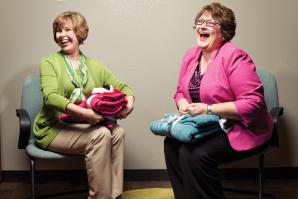Monica Gonzalez recently logged onto the Facebook page of Weave Inc., an organization that treats survivors of domestic and sexual abuse, to post a simple message about how the nonprofit helped her overcome a nightmarish ordeal.
“I’ll never forget all the help did you give me at those times and the shelter for my babys [sic] and I, at the support and to meet people with the same problems thanks a lot!!!! I love u!!!” she wrote.
For Gonzalez, a 42-year-old English learner from Mexico City, posting to Facebook was a helpful step on her road to empowerment. She hopes her message will incite other women in distress to seek help through Weave.
“I felt alone, and nobody can understand what I go through, nobody can hear me. So when I put that in Facebook, maybe [other victims] can get encouraged to go to other people to talk about it. I want to help,” she says.
2011 may be remembered as the year social media stoked a revolution in the Middle East, ended the career of one libidinous congressman and galvonized support for the people of Japan displaced by disaster. Facebook now has more than 800 million users — more than double the population of the U.S., and nonprofit organizations are taking notice.
According to Craigconnects, a web-based initiative operated by Craig Newmark of Craigslist, 92 percent of the 50 highest-revenue nonprofits have a Facebook presence, and 90 percent are on Twitter.
Worldwide, social media is booming, and online networking is redefining how nonprofits communicate with potential supporters, raise money and deliver authentic messages to rally the public around a cause.
“We made a choice to treat our social media differently than traditional media, where we dictate who speaks for the organization in a controlled message. One of our core values is empowering people to speak out,” says Beth Hassett, executive director of Weave.
But when people do want to tell their story online, organizations must exert caution. The Internet is a minefield of privacy issues, and organizations must be mindful of clients’ safety.
“It’s another crossroads we’re at with technology,” says Julie Bornhoeft, spokeswoman for Weave. “I remember when [caller identification] came out 20 years ago, every number was instantly public, but there had not been a lot of thought around safety. … In reality, technology will keep advancing and affecting how any nonprofit provides social service. Do you choose to embrace it and acknowledge benefits, or do you ignore it and potentially get left behind?”
Those wishing to stay ahead of the curve find people like Beth Kanter, technology consultant and co-author of “The Networked Nonprofit: Connecting with Social Media to Drive Change.” Seven years ago, Kanter says she would begin seminars on effective social media by asking everyone in the room to stand up if they used online networking to promote their organization. Most people in the room stayed seated.
“Now almost everyone is standing,” she says. “But when I say to remain standing if you think you are doing a good job at it, many sit down.”
Kanter says the first step is to seek the help of individuals who already have an established media presence.
“Younger people are fascinated with social media. They have created a whole social movement in the palm of their hands and are willing to leverage their networks on behalf of the nonprofit’s cause.”
Beth Kanter, technology consultant, and co-author, “The Networked Nonprofit: Connecting with Social Media to Drive Change”
“Younger people are fascinated with social media. They have created a whole social movement in the palm of their hands and are willing to leverage their networks on behalf of the nonprofit’s cause,” she says.
Randal Moss, co-author of “The Future of Nonprofits,” a guidebook to nonprofits for thriving in the digital age, notes that social networking sites are really a collection of different groups of people who share similar sensibilities. Therefore, nonprofits can tailor their message to a particular set of people that are more inclined than the general public to engage in a certain cause.
“Self-selection exists on the web on a number of issues,” Moss says. For example, “If I happen to be a specific religious denomination and maybe donating to a charity, there is a strong chance that my friends in my social network are like-minded.”
Identify and reach out to those people, Moss says. They will tell their friends and supporters, and your cause will grow.
“It takes more effort to explain to all my friends what I did on email; it’s very easy for me to hit a ‘share’ button,” Moss says. “And when friends start sharing what they didn’t before, not only does it spread into the network, but if you see that you’re friend Josh did something, you will be much more inclined to do it.”
It’s also important for nonprofits to build themselves a recognizable online brand, says Clay Nutting, account executive for 3fold Communications, a Sacramento-based marketing firm. One example of this is adding commentary when reposting an online article or video and then asking people to post their reactions.
“That’s where you really get engaged with your audience: when you’re asking them for their opinion,” he says.
And for Twitter users, don’t feel confined by the allotted 140 characters, Nutting says. The mini-blogosphere is great for linking to videos, provocative images, or other powerful online media or literature.
“The ability for your tweet or message to go viral is really the key,” he says. “People learn in a lot of different ways, so you don’t just want to talk out to people, you want to engage. If you want to be someone worth following, have something creative, relevant or interesting to say. And it doesn’t always have to be about your organization.”
Social media is not competing for the public’s attention. It’s about reaching out to other organizations that can help you, says Kate Towson, Americorp Vista and social media coordinator for Sacramento Steps Forward, an initiative for the homeless. Towson says she devotes about one third of her organization’s social media messaging on publicity for Sacramento Steps Forward, another third on raising community awareness on homelessness, and the final third on promoting other organizations that also fight for the underserved.
“I learned that a good social media person shares the love, promotes other agencies’ work,” she says. “And always be thankful and help people in the community who help you.”
With those rules in mind, expect tremendous results, says Towson. Last year, Sacramento Steps Forward set out to create a rotating shelter where different organizations would provide dinner, bed and breakfast to local homeless. The nonprofit had almost no capital to finance the project, but through social media, Towson directly communicated with potential donors. As funds began to pour in, she would post how much had been raised and how much more was needed. She also informed her followers where the money was going. For instance, how many sleeping bags could be purchased by a recent donation. That transparency built public trust in the project and boosted the credibility of the organization.
The online friends of the donors took notice, and they reached for their wallets. Thanks to the digital campaign, Sacramento’s less fortunate were able to get out of the cold and find some warm food and bedding.
“We sheltered tons of people,” she says. “It was a big success for us.”
Recommended For You

Philanthropy Isn’t What It Used to Be
Acuity with Crocker CEO Lial Jones
Since August 1999, Lial Jones has served as director of the Crocker Art Museum. During her tenure, she has led a capital campaign that successfully raised more than $120 million to finance the Teel Family Pavilion, a 125,000-square-foot addition that opened in October of 2010.

Expanding a Vision
New leadership means fresh ideas for Women in Philanthropy
Banning together 12 years ago, a group of local women sought out to help foster youth establish healthy lives after emancipation.



